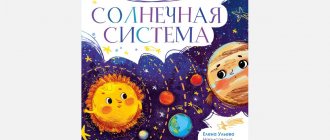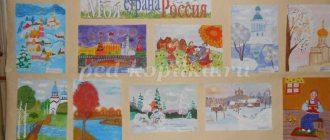Bright pictures with mushrooms, a story about each mushroom and coloring pages with mushrooms.
While exploring the wonderful world of nature, do not forget to tell your children in more detail about mushrooms - unique inhabitants of the natural world, occupying a middle position between the animal and plant kingdoms.
Children about mushrooms - mushroom pictures and stories
Lesson on the topic “Mushrooms” - we think, reason, find out
If you ask kids which group mushrooms belong to, they will no doubt answer – plants.
The following arguments can be given as evidence:
- sedentary lifestyle;
- passive nutrition (substances dissolved in water).
This is where you can give them a surprise by telling them that the structure of a fungal cell is more reminiscent of an animal cell - for example, a beetle or a scorpion, since it is covered with a chitinous (shell) shell. In addition, mushrooms cannot produce their own nutrients when exposed to sunlight, as plants do, which means this also serves as a distinguishing feature.
Ask the kids: where can you most often find a mushroom in the forest? Of course, under the tree. It is not for nothing that many mushrooms get their names from the names of their best friends - the trees under which they grow (aspen, birch). What explains this proximity? Just because mushrooms cannot provide themselves with all the necessary substances, as plants do. Therefore, many of them try to make friends with trees in order to get the products they lack through their roots.
Let's think about what large groups are all mushrooms divided into? Of course, there are edible and non-edible .
Edible and inedible mushrooms
Let the children remember the most famous representatives of each group, and you help them, armed in advance with photo cards depicting mushrooms.
For better assimilation and greater clarity, attach cards with the name of the group on the board or table: “Edible mushrooms” and “Inedible mushrooms.” After discussion, send each picture to the appropriate group. At the same time, it is better to study twin mushrooms in parallel, this will teach kids to be careful in the process of collecting them.
The video presentation “Edible Mushrooms” will help you in studying edible mushrooms:
Popular message topics
- Zhukovsky, the life and work
of Vasily Andreevich can be called one of the most important poets of the 18th century. Having studied the works of Western educators, he wrote wonderful things in which faith in bright times for the people was visible, in the fact that they could be - Crustaceans
Many animals that live in water bodies and seas belong to the class of crustaceans. It is not difficult to confuse them; the body of crustaceans has a special structure. They have a belly and a head, which is one with the chest. Breathing is carried out using gills. - Butterfly Admiral
The well-known butterfly Admiral is very beautiful. The front wings are decorated with a bright red stripe and white spots. The hind wings also have a red stripe, but it is located at the edges. The butterfly is quite large. The size of her front wing
Cards with images of mushrooms
As a rule, children know the following types:
Champignon. This mushroom is specially grown in greenhouses, since, unlike many of its fellows, it does not need proximity to trees. What two distinctive features of champignon do you need to remember? The first is the pink or dark brown color of the plates under the cap. The second is the reddish or yellow tint of the mushroom pulp. And, of course, you need to remember the unique aroma of this mushroom, which cannot be confused with anything else if you inhale it at least once.
Picture of champignon for children
Let us immediately remember what is the name of the double of this noble mushroom? Of course, the pale grebe. We look at its image, looking for distinctive features. The most observant will be able to note:
- white color of the plates under the cap;
- the presence of a specific sac at the base of the mushroom stalk.
We add that the flesh of the pale toadstool always remains pale when cut, which is why this mushroom got its name.
Picture of a toadstool for children
Let's move on and remember the following edible mushrooms:
Russula. This mushroom is distinguished by the brightness and variety of colors of its cap. It differs from toadstools in its thick stem, fleshy cap and fragile flesh. And it owes its name to the fact that it does not require long cooking, since it does not contain harmful substances.
Russula picture for children
Boletus. One of the brightest representatives of the union of mushrooms and trees. It is distinguished by the unusual (speckled) color of its stem and the tubular structure of its cap.
Picture of boletus for children
Boletus. From its name it is clear that this mushroom is especially friendly with aspen. And his cap is bright red - the same as aspen leaves in autumn.
Picture of boletus for children
Camelina differs from other mushrooms not only in its color, but also in the fact that its cut acquires a blue tint over time.
Picture of saffron milk cap for children
Honey mushrooms. Friendly mushrooms that grow on the stumps of cut down or dead trees. One of the latest mushrooms, appearing only at the beginning of autumn.
Picture of honey mushrooms for children
Butter. Unusual mushrooms growing in coniferous forests. Their cap is covered with a layer of oily liquid, which is how they got their name.
Picture of boletus for children
Milk mushroom. Everyone's favorite, the king of salted mushrooms. It has an unusual shape and a short leg. It is found in two forms - wet (its surface is covered with fringe and slightly damp) and dry - with a smooth cap.
Picture of breast milk for children
White mushroom, boletus. A noble representative of his species. It has a very thick, fleshy light-colored leg and a cap with a tubular bottom structure.
Picture of white mushroom for children
Chanterelles. Unusual red mushrooms, in which the stem smoothly turns into a cap with a wavy edge.
Picture of chanterelle mushrooms for children
Speaking about chanterelles, you immediately need to remember their dangerous counterpart - false chanterelles, and pay attention to their differences from real ones: unpleasant smell, bright color (with a reddish tint), smooth edges of the cap.
Let us immediately remember the most famous non-edible mushroom - fly agaric . Let's discuss where this name could come from. Children remember the fact that fly agaric is very dangerous for various insects, and our ancestors placed its mushrooms on the windows to prevent flies from flying into the house.
Picture of fly agaric mushroom for children
Every kid knows what this mushroom looks like, its color is so unique. Children will also be interested to know that the fly agaric cap can be not only red, but also brown or yellow.
Another very original inedible mushroom is tinder fungus . This is a perennial parasitic fungus that grows on a living tree or stump. There are quite a lot of different types. He is a forest orderly, decomposing organic compounds into mineral ones. Due to its beneficial properties, it is actively used in medicine. Interestingly, some of its species in some countries can be eaten subject to special preparation.
Picture of tinder for children
And finally, let's remember another unusual representative of the mushroom kingdom - the truffle. This delicious mushroom grows in deciduous forests, and under a layer of soil. Therefore, various methods are used to extract it. Pigs and specially trained dogs are especially good at finding truffles.
Picture of mushroom truffle for children
For greater clarity, we use a poster depicting all common edible and non-edible mushrooms, among which we find familiar ones, and also study previously unseen mushrooms.
Poster with mushrooms
Through a poster on which images of mushrooms are drawn, we smoothly move on to the next, reinforcing part of the lesson - pictures with mushrooms. Some of them display the main features of each mushroom, making it recognizable. On others we see the general outlines of mushrooms. You can offer the kids riddles or poems about mushrooms that match the pictures.
A picture for children of a mushroom (poems about mushrooms, riddles about mushrooms) are used to consolidate knowledge of the names of the main parts of the mushroom; with the help of them we try to remember how and in what parts, as well as in their characteristic habitat, the mushrooms that we studied today differ from each other.
for children and parents
If a competition was held in the kingdom of mushrooms for the most friendly and numerous family, then honey mushrooms would undoubtedly win. These mushrooms will never grow alone! They take a liking to a stump in the forest and stick around it so that sometimes even the stump itself is not visible. Come and collect a full basket of honey mushrooms in one place!
What do mushrooms look like? They have a convex cap, which becomes flat over time, but a tubercle remains in the middle of it. The color of the cap is yellow or brown, with reddish tint. If you break the cap and smell it, it will smell like wet wood. The legs of mushrooms are long and thin; they taper towards the base of the mushroom. The honey mushroom has a characteristic ring on its stem, which false mushrooms do not have.
It is important to be able to recognize false mushrooms, which are poisonous. Their cap is grayish-yellow or red, like a brick. False honey mushrooms do not have a ring or scales on the stem, and their smell is unpleasant.
The collection of honey mushrooms begins in August and continues until the first frost. They grow in the northern hemisphere. In our country, honey mushrooms are very popular, because they have an important advantage - every year a colony of honey mushrooms grows on the same stump. It is enough to remember where the treasured stump is located and you can come to it every year to harvest without bothering yourself with a search. Those who have honey mushrooms settled right on their dacha or garden plot are especially lucky.
You can prepare dishes from honey mushrooms in different ways. They are boiled, fried, salted and pickled.
Useful properties of honey mushrooms
Honey mushrooms contain natural antibiotics. They are rich in protein and have an antiviral effect. Honey mushrooms also contain a lot of vitamins B and C, and they also contain trace elements such as copper and zinc.
Text author: Lev Poyasnikin
This entry is password protected. Enter your password to view comments.
Riddles about mushrooms
For example, you can offer the following poems and riddles:
My hat -
Where the needles are.
Glistens in the sun
It slips in your hands. (oiler)
With a thick leg, small,
He hid in the moss... (boletus).
If I get into the basket -
You will have a supply for the winter.
I taste very good!
Did you guess it? This is... (milk).
They lead a friendly round dance
Red sisters.
Everyone will immediately understand:
In front of him... (chanterelles).
Sits bravely on a stump
A bunch of brave guys.
Everyone can easily recognize them:
Who doesn’t know about….(again)?
All shades and colors
Those mushrooms have caps.
Collect them without haste,
Very fragile...(russula).
Look at the video riddles about mushrooms:
As a conclusion to the lesson, to include motor memory in the work, in the final part we invite the kids to work with coloring. The mushroom coloring page puts kids in a calm mood.
CHAPTER
Gruzdev called himself get in the body! The genus of lacticifers (mushrooms containing milky juice) includes milk mushrooms: real, black, yellow, golden yellow, pepper. The true milk mushroom has a mucous cap, initially white, then slightly yellowish with slightly concentric stripes and a wavy-shaggy edge. The plates are descending, frequent, white and pinkish. There, under the spruce branches, we are looking for mushroom miracles. Black milk mushrooms have a dense look. The forest fascinates. L. Glazkov The pulp of milk mushrooms is white, dense, with a pleasant fruity smell. The milky sap is white and turns yellow in air. Very bitter. Milk mushrooms are found in birch and mixed forests. It is better to eat them salted. In Rus', milk mushrooms were salted in barrels; these mushrooms were considered the best for pickling. And according to the Siberian method, milk mushrooms were not salted separately, but together with other mushrooms from the genus of milkweeds - capillaries and saffron milk caps. Yellow milk mushrooms are found in spruce and spruce-fir forests. From August you can collect black milk mushrooms in birch forests. People called him Chernushka. This is a giant among other milk mushrooms - the cap can reach 20 cm in diameter. Its color is very dark, almost black – greenish-brown. People say: “It looks black, but it’s delicious inside.”
There is also a mushroom - a milk mushroom, which will drive away sadness from the soul. He looks like a funnel, White in color, Often hides to the side From the daylight. Salted breast milk is something! All mushrooms taste better! What fun is there to hunt for mushrooms? Let's go to the forest as soon as possible! E. Dolgikh The names of oak and aspen milk mushrooms speak for themselves - they grow in oak and aspen forests. But the flesh of the pepper milk mushroom is so pungent that when dried and crushed it can be used instead of seasoning for dishes. Milk mushrooms contain a lot of antioxidants, vitamins D and B12, they help with tuberculosis and kidney stones. RIDDLE In the moss, like on a pillow, Someone’s little white ear. (milk)
Mushroom coloring pages
Mushroom picture
Mushroom coloring book
Fly agaric picture for children
Fly agaric coloring book for children
Autumn mushroom picture
Autumn mushroom coloring
After finishing the work, you need to consider all the results and even make an impromptu exhibition of mushrooms painted in bright colors.
When do honey mushrooms appear?
Honey fungus can be found at any time of the year. It all depends on the type of mushroom and climatic conditions. For example, the autumn honey fungus begins to grow from the end of August, and its last representatives can be seen already at the beginning of winter. Winter honey fungus, accordingly, gives a good harvest in the cold season, and spring and summer ones begin to grow with the first warming.
Mushrooms grow best in rainy times - that’s when they have enough moisture, so late autumn and early spring are considered to be the honey mushroom season.
By the way, many people have probably noticed that after the rains there are many times more honey mushrooms. This is due to the fact that mushrooms love water and need a damp surface for better development. Temperature does not play a big role in their growth, because with the arrival of cold weather, one species begins to grow, and with the arrival of warmth, another. Thus, honey mushrooms can be harvested throughout the year.
Where to buy?
In specialized markets. There are veterinary and sanitary laboratories there, where they check whether radiation exposure is normal. Today there are several such markets in Yekaterinburg: Shartashsky, Uralmashevsky and Omega. Not enough for a big city - there is no information on new markets, but they wanted to build them soon. It is best to take mushrooms and berries from non-industrial areas. You should not buy those that were collected in the Kamensky, Asbestovsky districts and along the Pervouralsky tract.
Growing at home
Few people know that mushrooms can be grown at home, and honey mushrooms are no exception. There are several ways to place any of the types of this group of mushrooms.
The technology of growing on stumps is the method closest to the real growth of mushrooms. In order to plant your garden with honey mushrooms, you need to choose a place where there is a lot of shade, because, as mentioned earlier, honey mushrooms do not like direct sunlight. If there is no such place, then you will have to use straw to cover the habitat of the mushrooms. It is also worth remembering that you need to use the stumps of only deciduous trees: aspen, birch, apple, pear, acacia and others. You need to plant small pieces of mushrooms in a well-moistened tree and cover them with moss so that the mushrooms begin to germinate faster. Already next year it will be possible to harvest the first harvest, which will be regular for 6-7 years.
The technology of growing in glass jars is a method for urban mushroom lovers. It will require 1/3 bran and 2/3 sawdust from deciduous trees. To all this you will need to add starch and flour. After that, fill it all with water and boil. You can plant pieces of mushrooms into this cooled mixture, covering the jars with lids with holes. When the mushrooms germinate, the lids are removed. This method bears fruit much faster - within a month it will be possible to harvest the first harvest.




